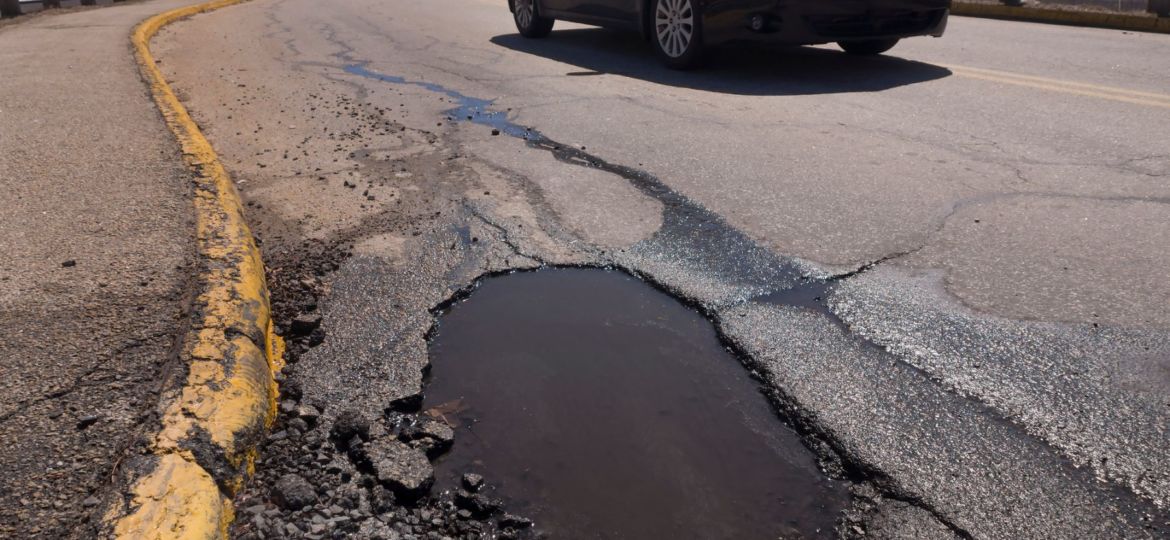
As the seasons change, we have to adapt and prepare for inclement weather and all of the conditions this brings. One of the major changes during winter months is the growing number of potholes that seem to “pop up.” let’s dive into the whys and hows to avoid and navigate them.
How Do Potholes Occur
Potholes don’t just appear out of nowhere, even though it seems like they might. Potholes form as a result of the expansion and contraction of water during freeze-thaw water cycles, combined with the amount of traffic on the pavement. Winter is a prime time for creating and growing potholes. Each time there is moisture on the pavement and the temperatures drop to freezing, ice forms and expands in the smallest cracks. The continued freezing and thawing weakens the pavement time and time again. which causes the material to break down from the weight, creating the pothole.
Okay, so now that we understand how our city acquires these impediments, let’s focus on how to navigate them and mitigate any potential car damage caused by them.
How to Avoid Potholes
First and foremost, regardless of the seasons, you should always ensure your tires are properly inflated. Under- and over-inflated tires are more likely to cause damage to your vehicle if you hit a pothole. This is your first line of defense against these pesky road quagmires. Make sure you know the proper pressure for your tires and remember, if it’s freezing out, you likely won’t be able to increase the air pressure in your tires, as it’s too cold to implement.
Next, you will want to put into play all of the safe driving practices you have learned. Don’t tailgate the vehicle in front of you. If you are following too closely, you won’t have time to avert your car and miss the upcoming pothole. By leaving more than the typical 3-4 second space cushion between you and the vehicle in front of you, will allow you to spot the pothole and adjust your speed or even allow you to merge into a different lane in a safe manner.
Avoid puddles on the road! This is a biggie. Often, you cannot judge the depth of a puddle or if it’s frozen or not. During winter months, these puddles could be concealing some very major potholes, and by assuming it’s just standing water, you could unintentionally do serious damage to your vehicle. Although it’s not always possible to miss puddles, the slower you cross them, the better the outcome for you and your vehicle.
Last, but not least, we’ve all heard this one before: SLOW DOWN. During the winter months, there are a myriad of reasons to drive slower than you normally do, but pothole avoidance might just make this your reason to actually lower your speed. If you can reduce your speed then you can likely spot that gnarly pothole a lot sooner. Did you know that hitting a pothole can equate to the force of a 35 mph car crash? Wouldn’t it just make sense to slow down if that means protecting your vehicle and any passengers inside?
The Damage is Done
So, what happens when you’ve done your best, but you simply encountered the wrong pothole? How do you determine if you have damage, and to what extent? Here are some common signs of damage from potholes:
Alignment – Does your steering wheel seem to be off-center? If this is the case, it’s very likely hitting the pothole has affected your alignment and will need to be readjusted. An extreme result could be damage to a steering component. Another sign of misalignment is when your car pulls to one side when driving straight.
Flat Tire – This will be the easiest sign of damage. Make sure your spare is handy and inflated, so you can get the flat off your vehicle as soon as possible and prevent further damage to the tire, the rim, and ultimately your vehicle.
Shaky Steering Wheel – This is likely indicative of a flat tire, bent rim, or now your wheels need to be balanced. Regardless, pull over, check the wheels, and assess if you can continue to travel on them until you can get the vehicle serviced.
Strange or Weird Noises – After encountering a pothole, if you start to experience unfamiliar noises, you might have done damage to the underbody of your vehicle or exhaust system. This type of damage will require getting your vehicle in for an inspection immediately.
These are just some of the more common signs of damage that could have been a result of hitting a pothole. Being aware of how your vehicle typically handles and sounds is the basis of recognizing if you might have damage after hitting a pothole.
What to do Next
Indianapolis strives to stay on top of potholes year-round. The city and INDOT take the problem of potholes seriously. Depending on the damage incurred from a pothole encounter, you can file a claim for reimbursement. The city also has a system to report potholes, so they can identify and repair quickly.
Report a pothole and file a claim here. Also, you are helping other drivers become aware of some surprising and damaging spots. So, do your part to help other drivers and the city keep all drivers safe.
For potholes on city streets or county roads, please contact the proper city or county maintenance department.










